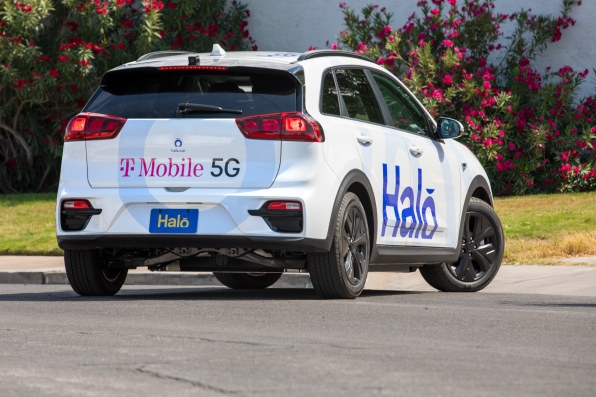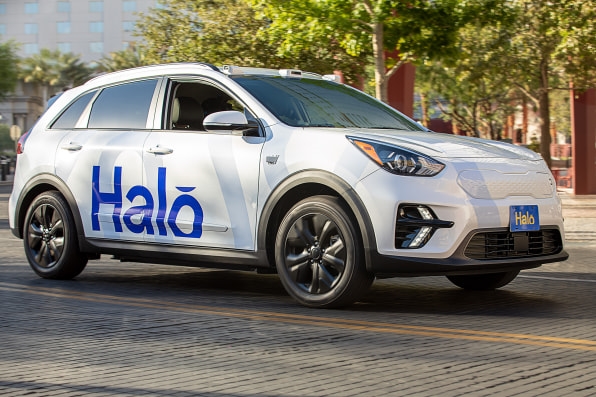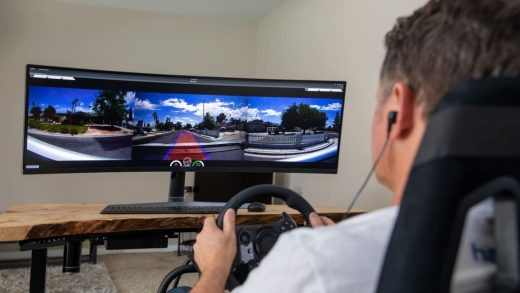This driverless car-sharing service uses remote human ‘pilots,’ not AI
T-Mobile is announcing a collaboration with a 5G-powered driverless car service that doesn’t actually use autonomous vehicles or require 5G mobile broadband. But Halo still merits a look for its odds of making Las Vegas traffic less of a losing bet.
The Vegas startup aims to use remote human driving to make car sharing more efficient—an issue that the pioneering car-share service Car2go couldn’t solve. You use Halo’s app to summon a Kia Niroelectric vehicle. It arrives empty but under the control of a remote driver. You drive it to your destination. Then a remote driver takes over again and the car is no longer your problem.
“You simply just hop off and go away, and the car disappears,” says Halo founder and CEO Anand Nandakumar. The company plans to launch with five cars later this year, operating at first “in urban parts of the Las Vegas Valley.”
Halo (no relation to the Halo concept car Cadillac unveiled at CES 2021, Amazon’s Halo health-tracking wristband, or Microsoft’s Halo series of games) opted to use 5G to keep a human in the loop instead of trying to make fully autonomous mobility work (a challenge even for slow delivery robots) and hoping the public will trust 40-mph software.
In Halo’s system, nine cameras feed video to a remote driver—whom Halo calls a pilot—with radar and ultrasonic sensors as a backup. The cars omit the expensive lidar sensors in most autonomous vehicles.
“You have better vision as a remote pilot than actually sitting inside the car,” Nandakumar says. “It’s significantly cheaper than any other autonomous vehicle company.”

The startup joined the 5G Open Innovation Lab T-Mobile helped found last year, allowing the wireless carrier to offer technical advice. The two companies aren’t saying if T-Mobile invested in Halo.
John Saw, T-Mobile’s executive vice president of advanced and emerging technologies, says that the company’s 5G brings significantly lower latency, especially on the faster mid-band spectrum that constitutes the heart of T-Mobile’s 5G sales pitch and dominates its coverage around Vegas.
But, Saw added, 5G isn’t quite as important as ensuring that a Halo car doesn’t have to fall back to 4G too often and risk interrupting the data stream during the transition.
“The car will actually work fine on LTE,” he said. But “each time you do a mode switch, you do have the potential to cause frame loss.”
Anshel Sag, an analyst with Moor Insights & Strategy whom T-Mobile and Halo briefed, says that faster uploads on 5G also matter.
“When the pilot is driving the vehicle between customers, they need to have a solid uplink more than a downlink, so that they can see what the car sees,” Sag said Wednesday.
Las Vegas also appealed to Halo because of local government’s openness to autonomous-vehicle experimentation. Halo’s press release quotes Southern Nevada Regional Transportation Commission vice chair Justin Jones as saying its service will “offer an intelligent transition between where we are today and where we want to go in the coming years.”
As for the traditionally-driven part of a Halo journey, the service will require a customer to be at least 25 years old and submit scans of the front and back of their driver’s license.
The system is prepared for the possibility that a customer in Sin City might not be okay to drive.
“When we actually get to a customer, we make sure that they’re not inebriated,” Nandakumar said. For instance, erratic steering, braking, or acceleration will trigger the car’s software to pull over.
Cheap, convenient, and realistic
Nandakumar didn’t answer questions about possible rates beyond saying “it’s going to be very, very affordable.” (Halo’s site touts an unspecified “upfront daily fee.”) Nandakumar added that the Niro’s 260-mile range helped make the concept work: “We keep the car running all day long, it comes back with another 50 miles left.”
Sag believes that not having to find a car before a ride or a parking spot afterwards could elevate this above earlier car-sharing services. “It’s a unique solution, in that the car comes to you,” he says. “That does alleviate some of the concerns around car sharing.”

Halo intends to make its cars slightly more autonomous, but its goals only extend to Level 3 of 5 on the Society of Automotive Engineers scale. Level 5 means fully driverless operation in all conditions, while 3 covers “conditional driving automation”—sufficient to serve as a “traffic jam chauffeur,” an SAE chart suggests.
Sag gave Halo credit for a level of realism that such firms as Tesla have not shown in aggressive autonomous-driving ambitions that they may now regret.
“I think of see this approach as the opposite of what Elon Musk has been suggesting, going from Level 2 to Level 5,” he said. “They’re taking a much more pragmatic approach.”
(45)



